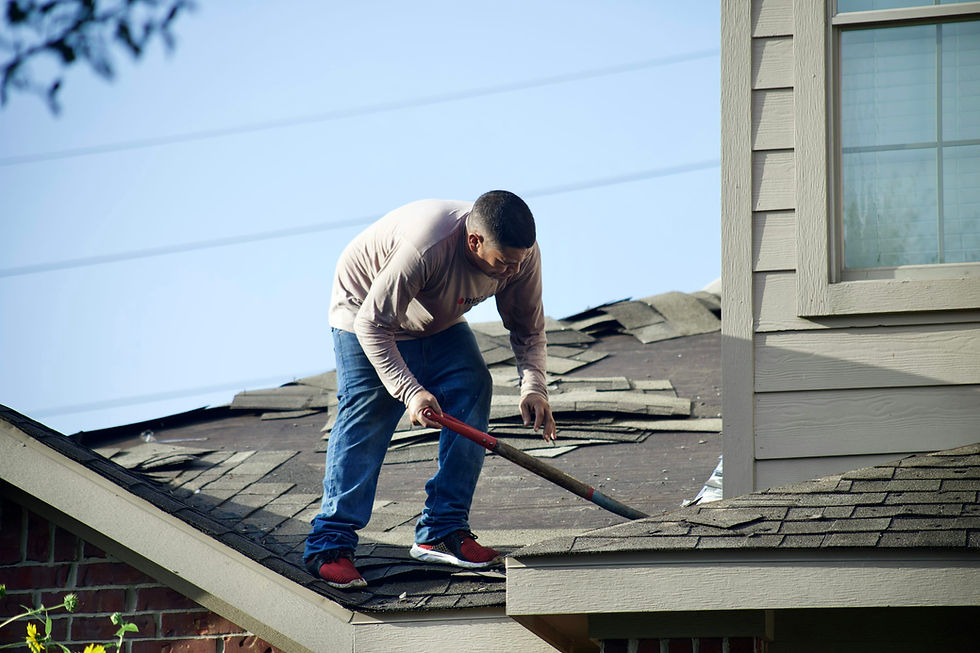Wind Mitigation for Florida Homes: What You Need to Know
- Honest Roofing FL

- Aug 19
- 7 min read
Industry Intel — April 19, 2025
Given Florida's vulnerability to hurricanes and severe storms, wind mitigation is essential for protecting homes. By reinforcing key structural components such as the roof, windows, and foundation, homeowners can reduce damage and lower insurance premiums. Simple measures like impact-resistant windows, roof reinforcements, and weatherproofing can significantly enhance a home’s wind resistance, offering both safety and financial savings.

Florida is one of the most beautiful states in the U.S., known for its tropical climate, stunning beaches, and vibrant communities. However, it is also notorious for its susceptibility to hurricanes and severe storms. As a result, ensuring your home is adequately equipped to withstand strong winds is crucial. Wind mitigation for Florida homes is essential for homeowners, as it can protect your property and lower your insurance premiums.
In this blog, we will explore wind mitigation, why it’s essential for Florida homes, how it works, and most importantly, what steps homeowners can take to improve their property’s resilience to high winds. By understanding and implementing these measures, homeowners can take an active role in protecting their homes.
What is Wind Mitigation?
Wind mitigation refers to the measures and techniques used to reduce the potential damage caused by windstorms, especially hurricanes, tornadoes, and tropical storms. In Florida, where hurricanes are a frequent threat, wind mitigation is key to maintaining a home’s safety and integrity. The goal is to fortify the structure and minimize the risk of wind-related damage to the house, which can result in costly repairs or even total loss.
Wind mitigation involves modifying a home’s construction to enhance its wind resistance. These modifications include upgrading various elements of the home’s structure, such as the roof, windows, doors, garage, and foundation. These improvements help ensure the house can withstand the powerful forces of a storm, reducing the chances of significant damage and increasing the home’s durability.
Why is Wind Mitigation Important in Florida?
Florida is particularly vulnerable to hurricanes and tropical storms due to its location. The state’s extensive coastline and tropical climate make it prone to frequent storms, especially during the Atlantic hurricane season, which runs from June to November. Florida is the state most impacted by hurricanes in the United States.
Every year, Florida faces the potential of severe storms with wind speeds exceeding 100 mph. These strong winds can cause extensive damage to homes and buildings, including the tearing off of roofs, breaking of windows, and destruction of exterior walls. The resulting destruction can lead to thousands, if not millions, of dollars in repair costs.
With the high cost of repairs and rebuilding after a storm, wind mitigation is about protecting your home and saving money. Homes properly fortified against wind damage are less likely to suffer extensive damage, meaning homeowners won’t have to spend as much on repairs or replacements after a storm. Moreover, wind mitigation measures can significantly lower your homeowner’s insurance premiums, providing long-term savings and financial security.
How Wind Mitigation Works
Wind mitigation works by reinforcing different aspects of a home’s structure to resist high winds and flying debris. This process typically involves the following:
Roof Reinforcement
The roof is one of the most vulnerable parts of a house during a storm. High winds can lift or tear off a roof if it is not properly anchored. Roof mitigation involves securing the roof to the house’s frame using metal straps, clips, or anchors. This improves the roof's ability to stay in place during strong winds.
A key element of roof reinforcement is ensuring the roof deck is securely attached to the trusses or rafters. Properly securing the roof to the wall framing is critical in preventing the roof from lifting off the house. Additionally, ensuring the roof covering material (such as shingles or tiles) is installed correctly can prevent it from being torn off by strong winds.
Impact-Resistant Windows and Doors
Windows and doors are common entry points for wind and debris during a storm. To mitigate this, homeowners can install impact-resistant windows or hurricane shutters. Impact-resistant windows are designed to withstand the force of flying debris and are much stronger than standard windows. These windows are made with laminated glass, which can absorb the impact of objects without shattering.
Hurricane-rated doors are also essential for wind mitigation. These doors are specifically designed to resist the pressure and impact of strong winds. Garage doors, in particular, can be a weak point in a home’s defence against high winds, as they are often large and less reinforced. Installing a reinforced garage door can help prevent the garage from collapsing under wind pressure.
Reinforcing Exterior Walls and Foundation
The exterior walls of a house are the first line of defence against wind pressure. Reinforcing these walls can help prevent them from collapsing or sustaining significant damage. Some reinforcement methods include using stronger materials for the walls, such as concrete or masonry, and installing metal braces to hold the walls in place.
Additionally, strengthening the home's foundation is an important part of wind mitigation. The foundation is the structural base that holds the entire house in place, so it needs to be secure. Homes in Florida often have slab foundations, which can be vulnerable to uplift during a storm. Reinforcing the foundation with additional anchoring or strap systems can prevent the house from being lifted off its base during high winds.
Installing Gable End Bracing
Gable ends are the triangular parts of the roof on either side of a building. These areas are particularly vulnerable to wind damage, as the wind can push against them with significant force. Installing gable end bracing is one of the most effective ways to prevent gable ends from collapsing during a storm. This involves adding diagonal braces or steel cables to reinforce the structure and prevent the wind from compromising the roof's stability.
Sealing and Weatherproofing
Sealing gaps around windows, doors, and vents is another essential step in wind mitigation. Wind can enter through small gaps and cause significant damage to the interior of the home. Additionally, water intrusion during a storm can lead to mould and rot. Proper weatherproofing ensures that water and wind cannot enter the house, keeping it dry and safe.
Wind Mitigation Inspections and Insurance Discounts
In Florida, wind mitigation inspections are a crucial part of the process. These inspections involve a certified professional examining the home to assess its wind resistance and identify improvement areas. The inspector will evaluate the roof, windows, doors, foundation, and other structural components to determine whether they meet current wind mitigation standards. This process ensures that homeowners are well-informed about the condition of their homes and can take necessary steps to improve their wind resistance.
After the inspection, homeowners receive a wind mitigation report that outlines the findings and recommendations. This report can be submitted to your insurance company to qualify for discounts on your homeowner’s premiums. Florida insurance companies offer significant savings to homeowners who implement wind mitigation measures, as the improved protection reduces the likelihood of a large payout after a storm.
Insurance companies may offer discounts based on the following:
The age of the roof and its wind resistance
The type of windows and doors installed
The condition and reinforcement of the home’s foundation and walls
The presence of additional wind-resistant features, such as gable end bracing and impact-resistant materials
It is important to note that these discounts vary by insurer, but they can often result in savings of several hundred dollars per year.
Steps Homeowners Can Take to Improve Wind Mitigation
Improving wind mitigation for your Florida home doesn’t have to be a complex or expensive process. You can take several steps to make your home more wind-resistant, whether you are building a new home or retrofitting an existing one.
1. Schedule a Wind Mitigation Inspection
The first step in improving your home’s wind resistance is to schedule a wind mitigation inspection. A certified inspector will assess your home’s vulnerability to wind damage and report improvement recommendations.
2. Install Impact-Resistant Windows and Doors
Installing impact-resistant windows and doors is one of the most effective ways to protect your home. These features are essential in areas most vulnerable to wind-driven debris, such as coastal regions.
3. Reinforce the Roof and Walls
Ensure your roof is securely fastened to the structure of your home. You can reinforce the roof by adding metal straps, clips, or anchors to strengthen the connection between the roof and the walls. Also, reinforcing exterior walls and the foundation can make your home more resistant to high winds.
4. Protect Garage Doors
Consider upgrading your garage door to one that is rated for hurricane-strength winds. This can prevent the garage from collapsing and reduce the risk of wind damage spreading throughout the home.
5. Add Gable End Bracing
If your home has a gable roof, install gable end bracing to prevent the roof from collapsing under the pressure of high winds.
6. Seal Gaps and Weatherproof
Seal all gaps around windows, doors, and vents to prevent wind and water from entering your home. Proper weatherproofing will help keep the interior of your home dry and protected during a storm.
Conclusion
Wind mitigation is a crucial aspect of homeownership in Florida. With the state’s frequent exposure to hurricanes and tropical storms, protecting your home from the potentially devastating effects of high winds is essential. You can reduce the risk of significant damage during a storm by reinforcing key areas of your home, such as the roof, windows, doors, and foundation.
Not only will wind mitigation improve your home’s safety, but it can also help you save money on insurance premiums. Homeowners who invest in wind-resistant features can qualify for significant discounts on their homeowner’s insurance, making it a worthwhile investment.
Whether building a new home or retrofitting an existing one, wind mitigation should be a top priority for Florida homeowners. It’s not just about protecting your property; it’s about ensuring peace of mind and safeguarding your investment for the long term.










